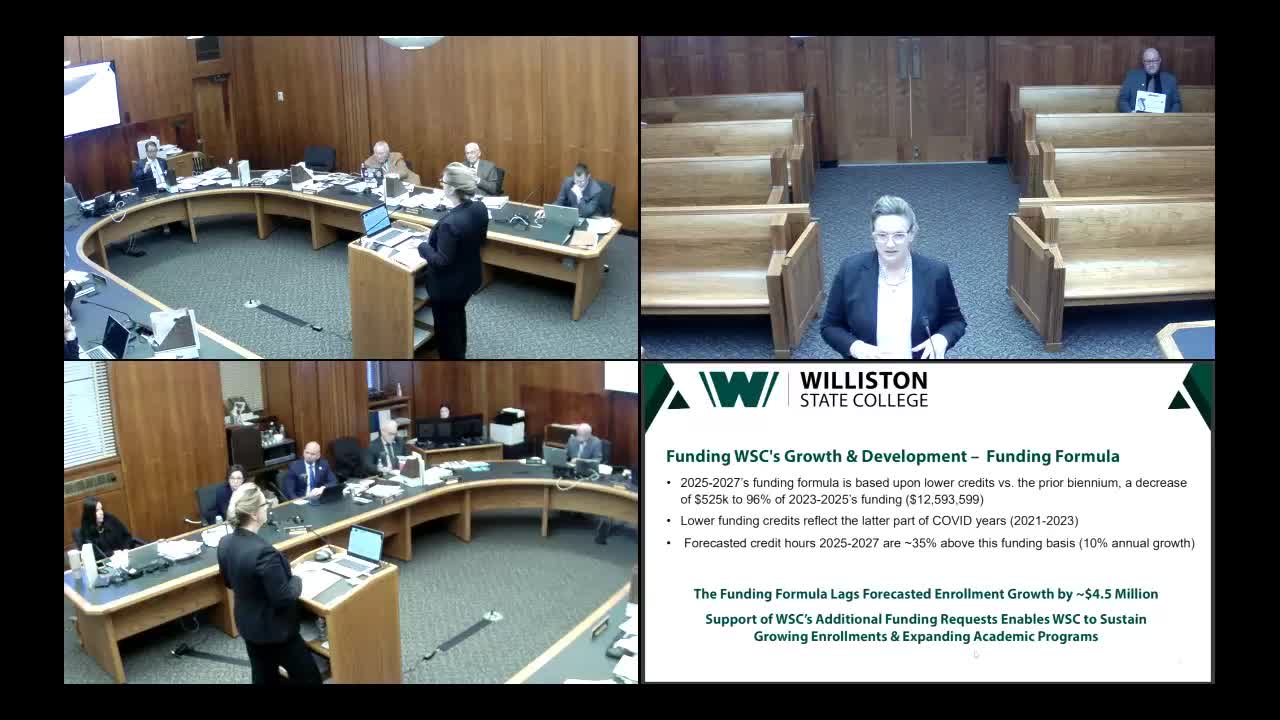Higher Ed Committee discusses funding challenges and dormitory needs amid inflation
March 11, 2025 | Appropriations - Education and Environment Division, House of Representatives, Legislative, North Dakota
This article was created by AI summarizing key points discussed. AI makes mistakes, so for full details and context, please refer to the video of the full meeting. Please report any errors so we can fix them. Report an error »

During a recent meeting of the North Dakota House Appropriations - Education and Environment Division, key discussions centered on funding challenges and infrastructure needs for higher education institutions in the state. The meeting, held on March 11, 2025, highlighted the pressing financial concerns faced by colleges, particularly in light of rising costs and fluctuating enrollment figures.
One of the primary topics was the impact of the current funding formula on higher education. Officials noted that many institutions are operating at approximately 35% above the funding formula, raising questions about sustainability if growth stalls or declines. The conversation included various scenarios regarding enrollment growth, with concerns that even a modest increase could leave institutions significantly short of necessary funding.
President Hanson and other committee members discussed the potential shift towards an on-time funding model for higher education, similar to what has been implemented for K-12 education. This change could provide more stability and predictability in funding, which is crucial as institutions grapple with inflationary pressures affecting operational costs, including utilities and medical expenses.
The meeting also addressed the urgent need for capital improvements across campuses. Representatives expressed gratitude for existing capital funds but acknowledged that many institutions are still lagging in addressing deferred maintenance issues. Upgrades to dormitories, security systems, and essential repairs were identified as critical needs to ensure student safety and comfort. The discussion underscored the importance of maintaining adequate housing to prevent student attrition, with some institutions already facing challenges in accommodating growing enrollment.
Concerns were raised about the financial viability of dormitory operations, which are expected to be self-sustaining. However, it was noted that many dormitories do not operate at full capacity, complicating efforts to generate sufficient revenue for necessary renovations. The committee recognized the delicate balance between funding dormitory upgrades and maintaining financial health, with some members suggesting that bonding might be a viable option for future projects.
In conclusion, the meeting underscored the urgent need for a comprehensive approach to funding and infrastructure in North Dakota's higher education system. As institutions face rising costs and fluctuating enrollment, the discussions highlighted the importance of strategic planning and collaboration to ensure that educational facilities can meet the needs of students and the community effectively. The committee's next steps will be crucial in addressing these challenges and securing the future of higher education in the state.
One of the primary topics was the impact of the current funding formula on higher education. Officials noted that many institutions are operating at approximately 35% above the funding formula, raising questions about sustainability if growth stalls or declines. The conversation included various scenarios regarding enrollment growth, with concerns that even a modest increase could leave institutions significantly short of necessary funding.
President Hanson and other committee members discussed the potential shift towards an on-time funding model for higher education, similar to what has been implemented for K-12 education. This change could provide more stability and predictability in funding, which is crucial as institutions grapple with inflationary pressures affecting operational costs, including utilities and medical expenses.
The meeting also addressed the urgent need for capital improvements across campuses. Representatives expressed gratitude for existing capital funds but acknowledged that many institutions are still lagging in addressing deferred maintenance issues. Upgrades to dormitories, security systems, and essential repairs were identified as critical needs to ensure student safety and comfort. The discussion underscored the importance of maintaining adequate housing to prevent student attrition, with some institutions already facing challenges in accommodating growing enrollment.
Concerns were raised about the financial viability of dormitory operations, which are expected to be self-sustaining. However, it was noted that many dormitories do not operate at full capacity, complicating efforts to generate sufficient revenue for necessary renovations. The committee recognized the delicate balance between funding dormitory upgrades and maintaining financial health, with some members suggesting that bonding might be a viable option for future projects.
In conclusion, the meeting underscored the urgent need for a comprehensive approach to funding and infrastructure in North Dakota's higher education system. As institutions face rising costs and fluctuating enrollment, the discussions highlighted the importance of strategic planning and collaboration to ensure that educational facilities can meet the needs of students and the community effectively. The committee's next steps will be crucial in addressing these challenges and securing the future of higher education in the state.
View full meeting
This article is based on a recent meeting—watch the full video and explore the complete transcript for deeper insights into the discussion.
View full meeting
